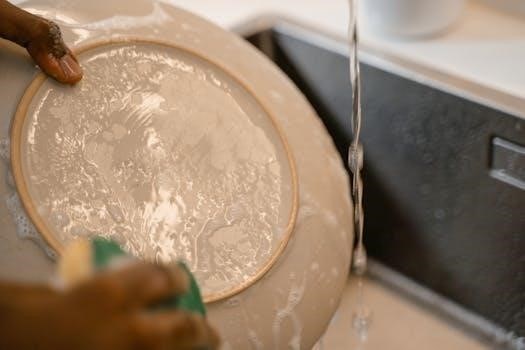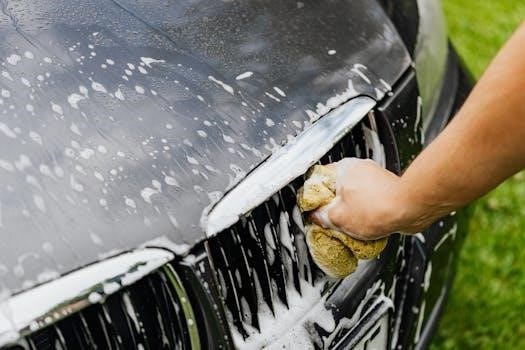How to Manually Regenerate a Water Softener
Manual regeneration is sometimes needed. It involves initiating the regeneration process yourself, usually by pressing a button or turning a knob. This is in contrast to automatic systems, which regenerate on a schedule. The process ensures continued water softening.
Understanding Water Softener Regeneration
Water softener regeneration is a crucial process that revitalizes the system, enabling it to continue providing softened water. Hard water, laden with calcium and magnesium ions, flows through the softener. During regeneration, the softener flushes out these accumulated minerals, effectively cleaning the resin beads. Old-school softeners relied on fixed cycles, needing manual calculations for optimal timing, considering water hardness and usage.
Modern softeners often use demand-initiated systems, adapting to actual water consumption for greater efficiency. Regeneration ensures the resin bed remains effective in removing hardness minerals. This process is vital for maintaining water quality and preventing scale buildup in pipes and appliances. Regular regeneration, whether automatic or manual, is key to extending the lifespan of the water softener and ensuring optimal performance.

Understanding regeneration cycles helps homeowners manage their water softener effectively. Manual regeneration offers control, especially when unusual water usage occurs or the automatic system malfunctions. Knowing the type of regeneration your softener uses allows you to troubleshoot issues and optimize its operation.
Why Manual Regeneration is Sometimes Necessary
While many water softeners are designed for automatic regeneration, there are situations where manual intervention becomes essential. If the softener runs out of salt, manual regeneration is needed after refilling to ensure proper function. Unusual water usage, such as during a large gathering or when filling a pool, can deplete the resin bed’s capacity faster than usual. In such cases, manually regenerating the softener can prevent hard water from entering your home.
Power outages can disrupt the automatic regeneration schedule, necessitating a manual restart. Similarly, if you’ve been away from home for an extended period, manually regenerating upon your return is advisable. A stuck timer on older models might also prevent automatic regeneration, requiring manual initiation.
Manual regeneration provides a way to address immediate water hardness issues and maintain optimal water quality. It’s a valuable troubleshooting step when the softener isn’t performing as expected or when circumstances disrupt the automatic cycle. By understanding when and why manual regeneration is needed, homeowners can proactively manage their water softening system.
Types of Water Softeners and Regeneration
Water softeners primarily fall into two categories regarding regeneration⁚ timer-based and demand-initiated. Timer-based softeners regenerate on a predetermined schedule, regardless of actual water usage. They are best suited for homes with consistent water consumption patterns. Demand-initiated softeners, on the other hand, monitor water usage and regenerate only when the resin bed is nearing exhaustion. These systems are more efficient, conserving both water and salt.
Both types can feature automatic or manual regeneration capabilities. Automatic systems handle regeneration without user intervention, while manual systems require the homeowner to start the process. Even automatic softeners often have a manual override function. Understanding the type of softener you have is crucial for proper maintenance.
The regeneration process itself involves flushing the resin bed with a brine solution, removing accumulated hardness minerals. The frequency and duration of regeneration cycles depend on the softener type, water hardness levels, and water usage patterns. Regularly checking your softener and understanding its regeneration process will ensure optimal performance and extend its lifespan.

Preparing for Manual Regeneration
Before initiating a manual regeneration, several steps are essential. First, ensure the brine tank has adequate salt. If the salt level is low, add more salt and allow it to dissolve in water for at least two hours, ideally four. The salt needs sufficient time to create a brine solution.
Next, check the water level in the brine tank. There should be enough water to dissolve the salt, but not so much that it overflows. If the tank is empty, add about six gallons of water. If there’s too much water, you may need to remove some. Also, confirm that the water softener is properly connected to a power source.
Identify the manual regeneration control on your softener. This is usually a button labeled “Regen” or “Recycle,” or a knob that needs to be turned. Consult your owner’s manual to find the exact location and operation of the manual regeneration control. Finally, be aware that during regeneration, softened water will not be available, so plan accordingly.
Step-by-Step Guide to Manual Regeneration
Initiating manual regeneration varies slightly depending on the model, but generally follows these steps. First, locate the regeneration button or knob on your water softener control panel. Press and hold the “Regen” button for approximately five seconds, or until the system display indicates that regeneration is starting. Some systems may require pressing the button once to display “Regen Today” and then pressing and holding again to begin the process.
If your system has a knob, turn it clockwise to the “Regen” position. You may hear a series of clicks as the valve advances. Once regeneration begins, the system will cycle through several stages, including backwash, brine draw, slow rinse, and rapid rinse. This process typically takes about 90 minutes to two hours.
During regeneration, avoid using water to ensure the process is not disrupted. Once completed, the system will automatically return to normal operation. Check the water hardness after regeneration to confirm its effectiveness. If the water is still hard, repeat the process or consider further troubleshooting.
Using the Recycle/Regen Button
The Recycle or Regen button on your water softener is the primary control for initiating a manual regeneration cycle. Its function is to override the automatic timer and start the regeneration process immediately. To use this button effectively, first locate it on your softener’s control panel. It is usually clearly labeled “Recycle” or “Regen.”
To start a manual regeneration, press and hold the Recycle or Regen button. The length of time you need to hold the button down can vary by model, but it is usually around three to five seconds. Watch the system display screen; it should change to indicate that the regeneration cycle is starting. For some models, the screen may display a message like “Regen Today” before initiating the cycle.
After the regeneration process begins, the system will automatically go through the necessary steps to clean the resin beads and recharge them with sodium ions. During this time, it is best to avoid using water to ensure uninterrupted regeneration. Once the cycle is complete, the system will return to its normal softening operation.
Using a Screwdriver to Manually Advance the Valve
In some older water softener models, particularly those with mechanical timers, you might need to use a screwdriver to manually advance the valve and initiate regeneration. This method is typically employed when the timer is stuck or malfunctioning. Before attempting this, ensure that the softener is disconnected from the power supply to prevent any electrical hazards.
First, locate the softener valve screw. It is typically found on the timer motor housing. Using a Phillips head screwdriver, gently push down on the screw and slowly turn it clockwise. As you turn the screw, you should hear distinct clicks, indicating that the valve is moving through its different cycles.
Continue turning the screw until the indicator dot on the valve aligns with the “Brine” or “Regen” position. This position initiates the regeneration cycle. You should hear at least five clicks while turning the screw before the indicator dot reaches the correct position. Once aligned, the softener should begin the regeneration process. Monitor the system to ensure it proceeds as expected. If it does not, double-check the valve position and try again.
Preparing the Brine Tank
The brine tank is a crucial component of your water softener system, and properly preparing it is essential for effective regeneration. Before initiating a manual regeneration, inspect the brine tank to ensure it has an adequate salt level. The tank should be approximately one-third to one-half full of salt. If the salt level is low, add more softener salt, ensuring you use the type recommended by the manufacturer—either rock salt, solar salt, or evaporated salt pellets or crystals.
Next, check the water level in the brine tank. There should be a small amount of water present, but if the tank is completely dry, add about six gallons of water before proceeding with regeneration. Allow the salt to dissolve in the water for at least two hours, or preferably four hours, to create a brine solution. This solution is necessary for the ion exchange process that removes hardness minerals from the resin beads.
Also, clear any salt bridges or clumps that may have formed in the tank. These can prevent the salt from dissolving properly and hinder the regeneration process. Use a broom handle or similar tool to break up the salt and ensure it is loose and free. A well-prepared brine tank ensures the softener can efficiently regenerate and provide soft water.

How Long Regeneration Takes
The duration of a water softener regeneration cycle is an important factor to consider, especially when manually initiating the process. Generally, a typical regeneration cycle takes approximately one and a half to two hours to complete. However, the exact time can vary depending on several factors, including the size of the water softener, the level of hardness in the water, and the specific model of the unit.
During the regeneration process, the softener goes through several stages, including backwashing, brining, rinsing, and refilling. Each of these stages requires a certain amount of time to ensure proper cleaning and recharging of the resin beads. Backwashing removes sediment and debris from the resin bed, while brining introduces the salt solution to displace the hardness minerals. Rinsing then flushes out the excess salt and minerals, and refilling prepares the brine tank for the next regeneration cycle.
Manually regenerating your water softener may require you to monitor the process to ensure it completes successfully. Avoid using water during the regeneration cycle to prevent disrupting the process and to ensure the most effective regeneration. Once the cycle is complete, your water softener will be ready to provide soft water again.

Troubleshooting Common Issues
When manually regenerating a water softener, several issues may arise. One common problem is a stuck timer, which prevents the softener from initiating the regeneration cycle. Many softeners allow manual triggering. If that works, you may need a timer replacement. Another potential issue is the lack of water in the brine tank;
If the brine tank is empty, add approximately six gallons of water and wait for about two hours before starting regeneration. This allows the salt to dissolve properly. It’s also essential to ensure that the water softener is set up correctly. A water analysis can determine hardness, iron, and manganese levels, which helps in proper configuration.
If you notice the softener isn’t regenerating, check for error messages on the display screen and consult the user manual for troubleshooting steps. Ensure the recycle/regen button is functioning correctly. If the softener displays a flashing message, pressing and holding the regen button for five seconds can sometimes jumpstart the process. Addressing these common issues can help maintain the efficiency of your water softener.
When to Consider Professional Help
While many water softener issues can be resolved with manual regeneration and basic troubleshooting, certain situations warrant professional assistance. If you’ve attempted manual regeneration multiple times without success, or if the system continues to exhibit problems, it might be time to consult a qualified technician. Complex issues such as valve malfunctions or internal component failures often require specialized knowledge and tools to diagnose and repair.
Persistent problems like excessively hard water despite regeneration, unusual noises during operation, or leaks around the unit are indicators of potentially serious issues that a professional can address. If you’re uncomfortable working with plumbing or electrical components, seeking professional help is a safer option. Furthermore, if your water softener is relatively old or has a history of frequent breakdowns, it may be more cost-effective to consider replacement rather than continually investing in repairs.
A professional can assess the overall condition of your system and provide expert advice on whether to repair or replace it, ensuring optimal water softening performance.

No Responses